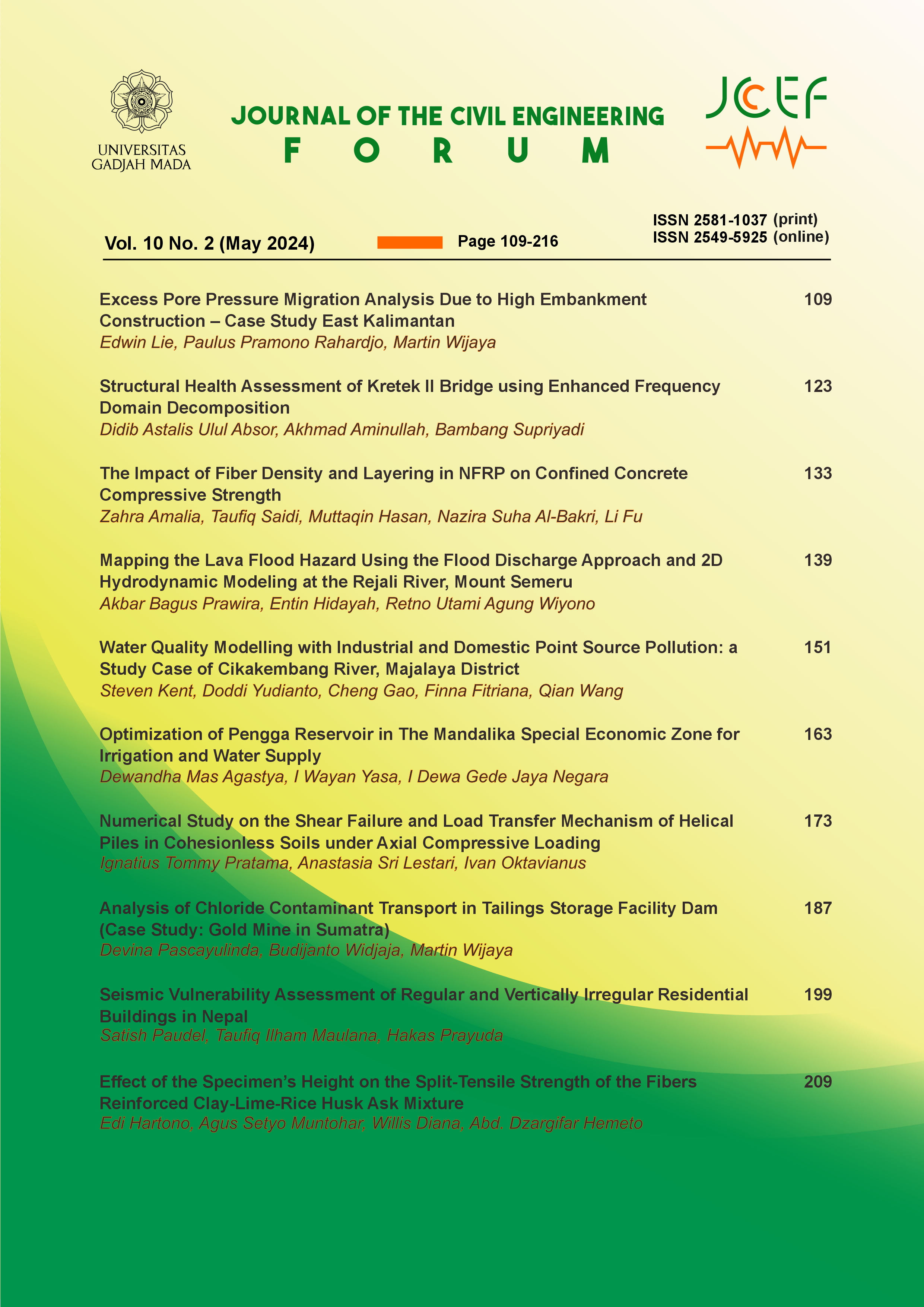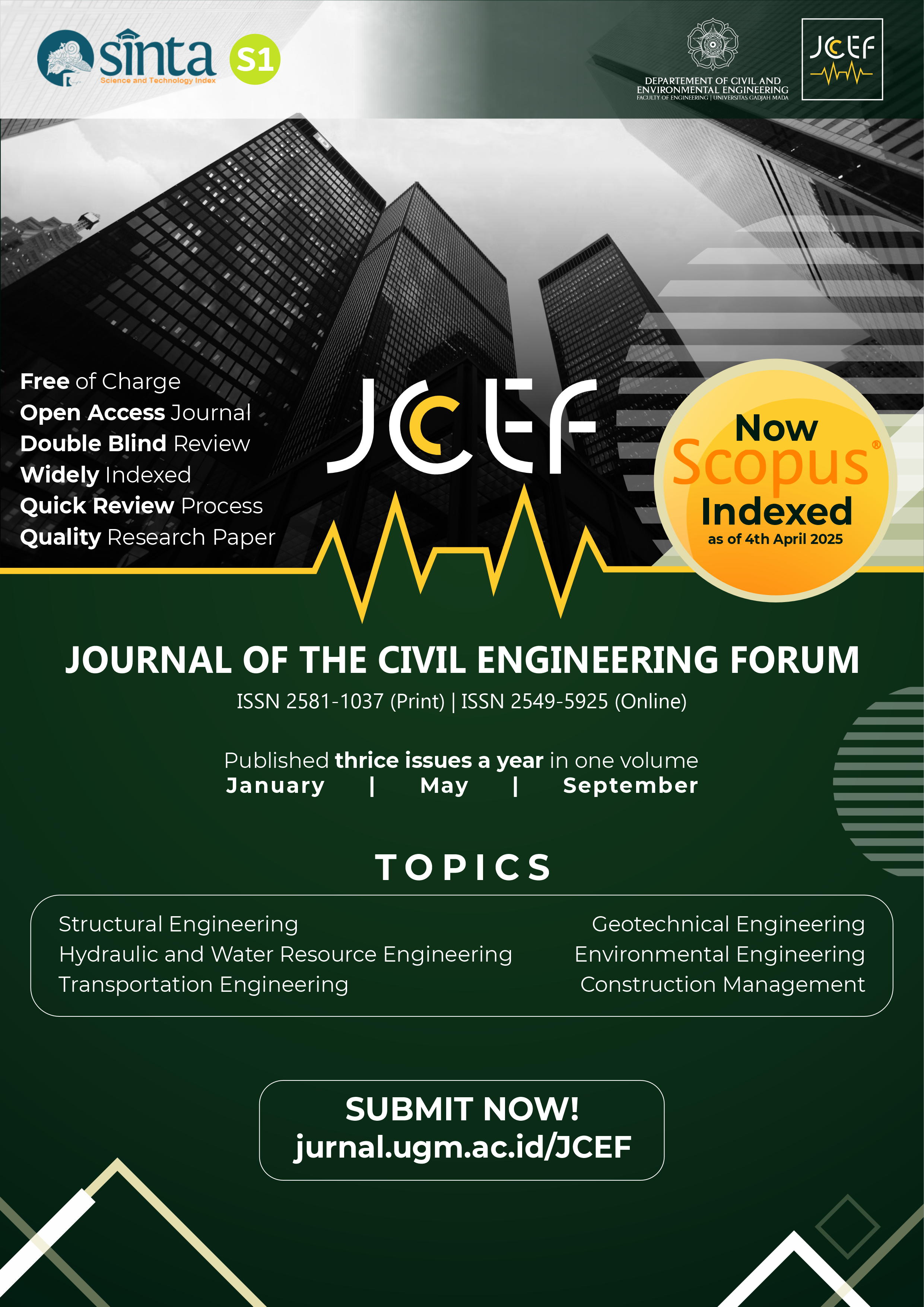Mapping the Lava Flood Hazard Using the Flood Discharge Approach and 2D Hydrodynamic Modeling at the Rejali River, Mount Semeru
Abstract
In December 2021, Mount Semeru experienced an eruption accompanied by extreme rainfall, which resulted in lava floods, known as lahars or debris flows. The lava flood destroyed infrastructure, resulting in loss of life. Various rivers surrounding Mount Semeru, including the Rejali River, experienced the effects of this phenomenon. To address this, a study is needed to analyze the occurrence and frequency of lava floods over specific time intervals through the creation of a hazard map. This study aims to map the hazard of lava floods for various return periods using a coupled HEC-HMS and HEC-RAS software alongside a lava flood discharge approach. The HEC-HMS software is used to simulate hydrological processes, to obtain the lava flood discharge, while the HEC-RAS is used to model a two-dimensional (2D) lava flood hazard map. The input parameters of the modeling in this study are rainfall intensity, soil type, land cover, river distance, slope, and elevation. The results show that the flood area covers 9.55% of the total study area by 2 year return period (Q2), 11.80% by Q10, 14.10% by Q50, and 15.72% by Q200 with an overall validation Root Mean Square Error (RMSE) of 0.16. These changes are determined by the discharge volume from each return phase and the river's shallow depth, which causes overflow beyond the river's ability to accommodate the flow. Thus, this study suggests that the models successfully generated a reliable model for mapping the risk of lava floods on the Rejali River. These findings can help the government reduce disaster losses through adequate adaptation and mitigation initiatives.
References
Abdessamed, D. and Abderrazak, B. (2019), ‘Coupling HEC-RAS and HEC-HMS in rainfall–runoff modeling and evaluating floodplain inundation maps in arid environments: a case study of Ain Sefra City, Ksour Mountain. SW of Algeria’, Environ. Earth Sci. 78(19), 1–17. URL: https://doi.org/10.1007/s12665-019-8604-6
Abdessamed, D. and Bouanani, A. (2017), ‘Hydrological modeling in the semi-arid region using HEC-HMS model. case study in Ain Sefra watershed, Ksour Mountains (SW-Algeria)’, Journal of Fundamental and Applied Sciences (May). URL: https://doi.org/10.4314/jfas.v9i2.27
Abu-hashim, M., Mohamed, E. and Belal,A. E. A. (2015), ‘Identification of potential soil water retention using hydric numerical model at arid regions by land-use changes’, Int. Soil Water Conserv. Res. 3(4), 305–315. URL: https://doi.org/10.1016/j.iswcr.2015.10.005
Arimbi, Y., R., S. and Winarta, B. (2022), ‘Pemodelan aliran Sungai Jatiroto menggunakan software HEC-RAS 5.0.7’, 2(2), 273–285.
Brunner, G. W. (2016), HEC-RAS User’s Manual, U.S. Army Corps of Engineers, California.
Brunner, G. W., Sanchez, A., Molls, T. and Parr, D. A. (2018), HEC-RAS verification and validation tests, Technical Report RD-52, USACE.
Elfeki, A., Masoud, M. and Niyazi, B. (2017), ‘Integrated rainfall–runoff and flood inundation modeling for flash flood risk assessment under data scarcity in arid regions: Wadi Fatimah basin case study, Saudi Arabia’, Nat. Hazards 85(1), 87–109. URL: https://doi.org/10.1007/s11069-016-2559-7
Fahmi,A. H., Suripin, S.,Wulandari, D. A. and Murod, K. (2022),‘Pemodelan hujan limpasan menggunakan HEC-HMS pada daerah tangkapan air Waduk Wonogiri’, Syntax Literate; Jurnal Ilmiah Indonesia 7(4), 3795–3807.
Gupta, L. and Dixit, J. (2022), ‘Estimation of rainfallinduced surface runoff for the Assam region, India, using the GIS-based NRCS-CN method’, J. Maps p. 1–13. URL: https://doi.org/10.1080/17445647.2022.2076624
Hamdi, M., El Molla, D. A. and Gad, M. A. (2019),‘A comparison between 1D, 2D and semi 2D hydraulic models’, Al -Azhar Univ. Civ. Eng. Res. Mag. 41(4), 295–305.
Hashim, H. Q. and Sayl, K. N. (2022),‘Incorporating GIS technique and SCS-CN approach for runoff estimation in the ungauged watershed: A case study west desert of Iraq’, Iraqi J. Civ. Eng. 14(2), 1–6. URL: https://doi.org/10.37650/ijce.2020.172862
Hou, J., Liu, F., Tong, Y., Guo, K., Ma, L. and Li, D. (2020), ‘Numerical simulation for runoff regulation in rain garden using 2D hydrodynamic model’, Ecol. Eng. 153(March), 105794. URL: https://doi.org/10.1016/j.ecoleng.2020.105794
Idfi, G. (2017), ‘Perbandingan model aliran banjir unsteady flow dan steady flow pada Sungai Ngotok Ring Kanal’, Bangunan 22(2), 31–40.
Julzarika, A. and Carolita, I. (2015),‘Klasifikasi penutup lahan berbasis objek pada citra satelit spot dengan menggunakan metode tree algorithm (object based on land cover)’.
Keputusan Menteri Pemukiman dan Prasarana Wilayah (2004),‘Perencanaan teknis tanggul pada sungai lahar’.
Kholiq, M. A. (2017), ‘Simulasi aliran banjir lahar pasca erupsi Gunung Merapi 2010 terhadap keberadaan sabo dam di Sungai Gendol’, J. Tek. XXII(2), 410–415.
Mishra, S. K., Babu, P. S. and Singh,V. P. (2007),‘SCS-CN method revisited’, Adv. Hydraul. Hydrol. . (January).
Munna, G. M., Alam, M. J. B., Uddin, M. M., Islam, N., Orthee,A. A. and Hasan, K. (2021),‘Runoff prediction of surma basin by curve number (CN) method using ARCGIS and HEC-RAS’, Environ. Sustain. Indic. 11, 100129.
Nakatani, K., Kosugi, K. and Satofuka, Y. (2021), Debris flow simulations due to landslide dam outburst and considering effective countermeasures, p. 235–240.
Narwade, R., Pathak, H., Panhalkar, S., Kulkarni, V. S. and Hingmire, A. P. (2022),‘Review paper for floodplain mapping with applications of HEC-HMS, HEC-RAS and ArcGIS softwares – a remote sensing and GIS approach’, J. Pendidik. Geogr. 26(1), 15–29.
Permatasari, A. L., Suherningtyas, I. A. and Wiguna, P. P. K. (2021), ‘Kesiapan infrastruktur data spasial sebagai upaya mitigasi banjir lahar di kali putih Kabupaten Magelang Jawa Tengah’,J. Pendidik. Geogr. 26(1), 15–29.
Purba, A., Sumantri, S. H., Kurnadi, A., Raka, D. and Putra, K. (2022),‘Analisis kapasitas masyarakat terdampak erupsi Gunung Semeru’, 6(2), 599–608.
Scharffenberg, W. and FM (2016), Hydrologic Modeling System HEC-HMS v3.5: users manual. Tigor Oktaga, A., Suripin, S. and Darsono, S. (2016),
‘Perbandingan hasil pemodelan aliran satu dimensi unsteady flow dan steady flow pada banjir kota’, Media Komun. Tek. Sipil 21(1), 35. URL: https://doi.org/10.14710/mkts.v21i1.11229
Traore, V. B., Bop, M., Faye, M., Giovani, M., Traore, V. B., Malomar, G., Hadj, E., Gueye, O.,
Sambou, H., Dione, A. N., Fall, S., Diaw, A. T., Sarr, J. and Beye, A. C. (2015), ‘Using of HEC-RAS model for hydraulic analysis of a river with agricultural vocation: A case study of the Kayanga river basin, Senegal’, Am. J. Water Resour. 3(5), 147–154. URL: https://doi.org/10.12691/ajwr-3-5-2
Ulinnuha, I., Prasetyo, Y. and Sabri, L. (2020), ‘Analisis spasial aliran lahar menggunakan HEC-HMS dan HEC-RAS pada Kali Gendol-Opak kawasan Gunung Merapi’, J. Geod. Undip 9(1), 20–28.
Victory, D. E., Siswanto and Trimaijon (2016), ‘Kajian lebar bangunan pelimpah tipe lengkung terhadap elevasi muka banjir (studi kasus Waduk Tenayan)’, 3.
Yanuarto, T. (2020), ‘Hujan lebat picu banjir lahar hujan dari Gunung Semeru’, Badan Nas. Penanggulangan Bencana .
Copyright (c) 2024 The Author(s)

This work is licensed under a Creative Commons Attribution-ShareAlike 4.0 International License.
Copyright is granted to authors for the purpose of providing protection for articles written to describe experiments and their results. JCEF will protect and defend the work and reputation of the author and are also willing to address any allegations of violation, plagiarism, fraud, etc. against articles written and published by JCEF. JCEF is published under the terms of the Creative Commons Attribution-ShareAlike 4.0 International License (CC BY-SA 4.0). The author holds the copyright and assigns the journal rights to the first publication (online and print) of the work simultaneously.





